Oldsmobile Achieva 1998 s Owners Manual
Manufacturer: OLDSMOBILE, Model Year: 1998, Model line: Achieva, Model: Oldsmobile Achieva 1998Pages: 356, PDF Size: 18.04 MB
Page 91 of 356
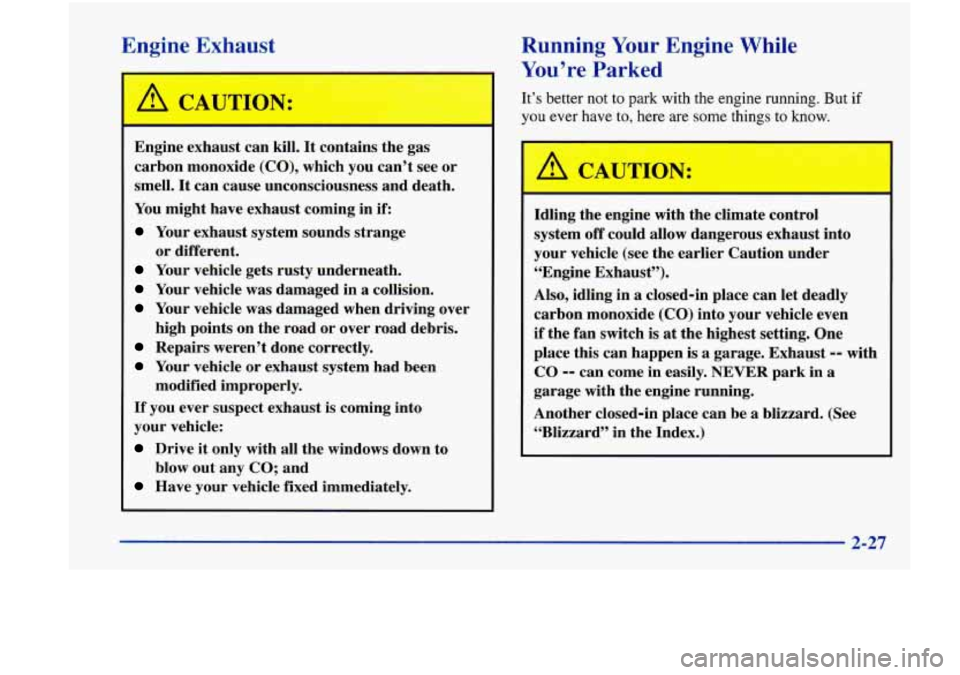
Engine Exhaust
,A CAUTION:
Engine exhaust can kill. It contains the gas
carbon monoxide
(CO), which you can’t see or
smell.
It can cause unconsciousness and death.
You might have exhaust coming in if:
Your exhaust system sounds strange
Your vehicle gets rusty underneath.
Your vehicle was damaged in a collision.
Your vehicle was damaged when driving over
high points on the road or over road debris.
Repairs weren’t done correctly.
Your vehicle or exhaust system had been
If you ever suspect exhaust is coming into
your vehicle:
Drive it only with all the windows down to
Have your vehicle fixed immediately.
or
different.
modified improperly.
blow out any
CO; and
Running Your Engine While
You’re Parked
It’s better not to park with the engine running. But if
you ever have to, here are some things to know.
A 1
a CAUTION:
I
Idling the engine with the climate control
system
off could allow dangerous exhaust into
your vehicle (see the earlier Caution under
“Engine Exhaust”).
Also, idling in a closed-in place can let deadly
carbon monoxide
(CO) into your vehicle even
if the fan switch is at the highest setting. One
place this can happen is
a garage. Exhaust -- with
CO -- can come in easily. NEVER park in a
garage with the engine running.
Another closed-in place can be a blizzard. (See
“Blizzard” in the Index.)
2-
Page 92 of 356

I A CAUTION:
I Windows
It can be dangerous to get out of your vehicle if
the shift lever is not fully in PARK (P) with the
parking brake firmly set. Your vehicle can roll.
Don’t leave your vehicle when the engine
is
running unless you have to. If you’ve left the
engine running, tlieVehiele can move suddenly.
You or others could be injured.
To be sure your
vehicle won’t move, even when you’re on fairly
level ground, always set your parking brake and
move the shift lever to
PARK (P).
Follow the proper steps to be sure your vehicle won’t
move. See “Shifting Into
PARK (P)” in the Index.
If you are parking on a hill and
if you’re pulling a
trailer, also see “Towing a Trailer”
in the Index.
Manual Windows
On a vehicle with manual windows, use the window
crank
to open and close each window.
Power Windows (If Equipped)
Switches on the driver’s
armrest control each
of the
windows when the ignition
is on. In addition, each
passenger door has a switch
for its own window.
2-28
Page 93 of 356
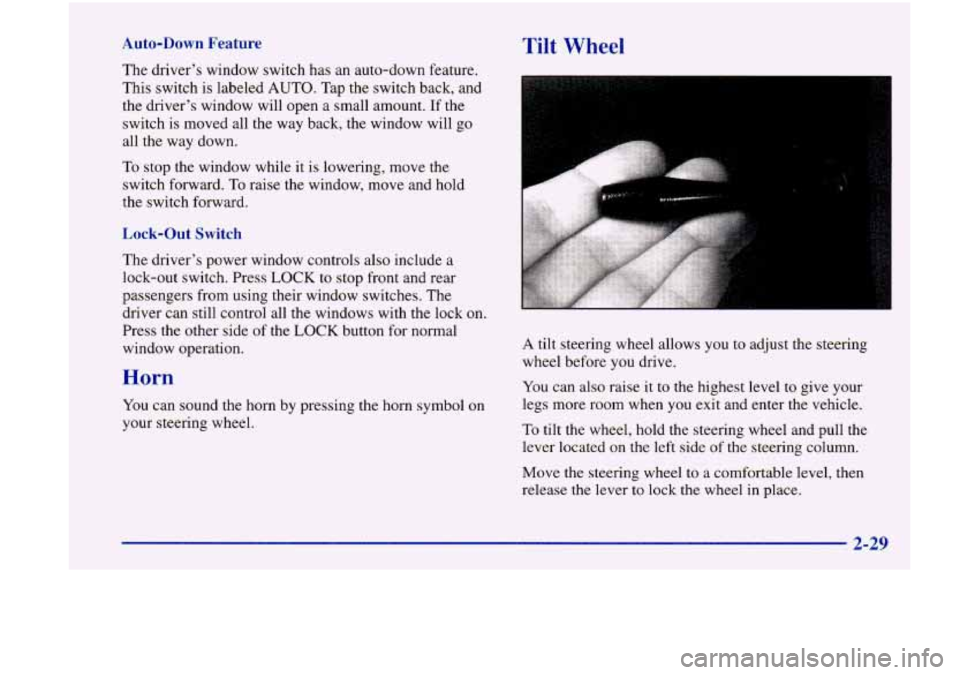
Auto-Down Feature Tilt Wheel
The driver's window switch has an auto-down feature.
This switch is labeled AUTO. Tap the switch back, and
the driver's window will open a small amount. If the
switch is moved all the way back, the window will go
all the way down.
To stop the window while it is lowering, move the
switch forward. To raise the window, move and hold
the switch forward.
Lock-Out Switch
The driver's power window controls also include a
lock-out switch. Press
LOCK to stop front and rear
passengers from using their window switches. The
driver can still control all the windows with the lock on.
Press the other side
of the LOCK button for normal
window operation.
Horn
You can sound the horn by pressing the horn symbol on
your steering wheel.
A tilt steering wheel allows you to adjust the steering
wheel before you drive.
You can also raise it to the highest level to give your
legs more room when you exit and enter the vehicle.
To tilt the wheel, hold the steering wheel and pull the
lever located on the left side of the steering column.
Move the steering wheel to a comfortable level, then
release the lever to lock
the wheel in place.
Page 94 of 356
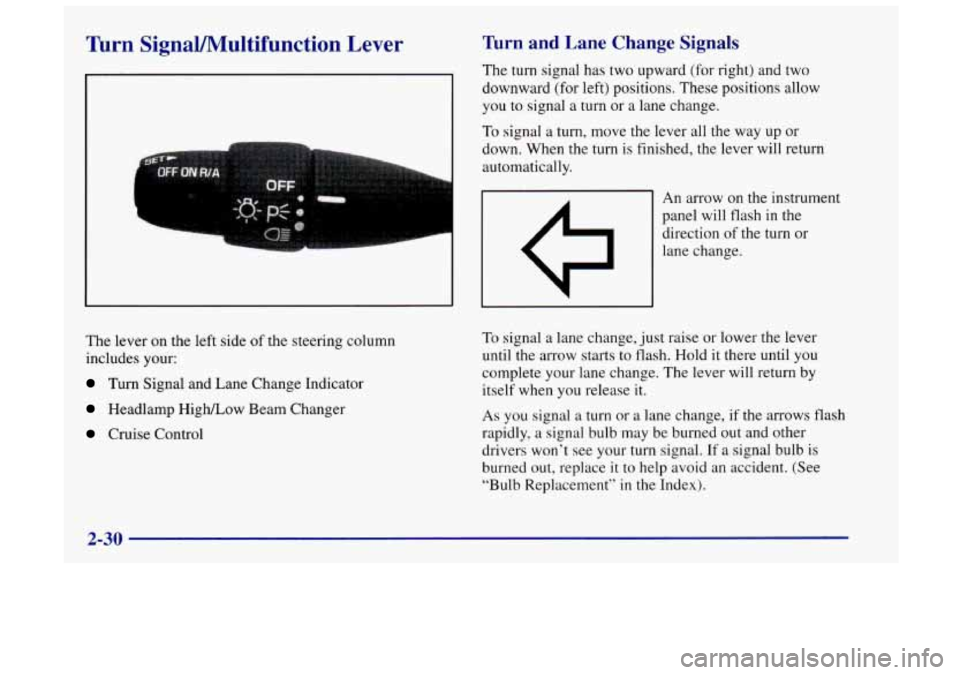
Turn SignaVMultifunction Lever Turn and Lane Change Signals
The turn signal has two upward (for right) and two
downward (for left) positions. These positions allow
you to signal a turn or a lane change.
To signal a turn, move the lever all the way up or
down. When the turn is finished, the lever will return
automatically.
An arrow on the instrument
panel will flash in the
direction
of the turn or
lane change.
The lever
on the left side of the steering column
includes your:
Turn Signal and Lane Change Indicator
Headlamp High/Low Beam Changer
Cruise Control To
signal a lane change, just raise
or lower the lever
until the arrow starts to flash. Hold it there until you
complete your lane change. The lever will return by
itself when you release
it.
As you signal a turn or a lane change, if the arrows flash
rapidly, a signal bulb may be burned out and other
drivers won’t see your turn signal.
If a signal bulb is
burned out, replace it to help avoid an accident. (See
“Bulb Replacement”
in the Index).
2-30
Page 95 of 356
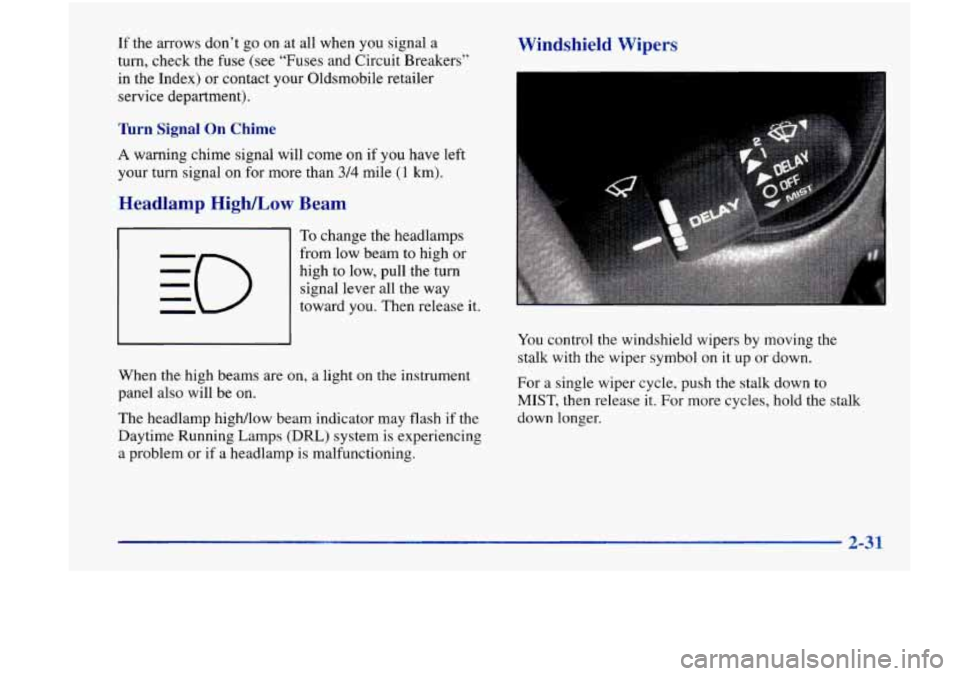
If the arrows don’t go on at all when you signal a
turn, check the fuse (see “Fuses and Circuit Breakers”
in the Index) or contact your Oldsmobile retailer
service department).
Turn Signal On Chime
A warning chime signal will come on if you have left
your turn signal
on for more than 3/4 mile (1 km).
Headlamp HighLow Beam
To change the headlamps
from low beam to high or
high to low, pull the turn
signal lever all the way
toward you. Then release it.
When the high beams are on, a light on the instrument
panel also will be on.
The headlamp high/low beam indicator may flash if the
Daytime Running Lamps
(DRL) system is experiencing
a problem or if a headlamp is malfunctioning.
Windshield Wipers
You control the windshield wipers by moving the
stalk with the wiper symbol on it up or down,
For a single wiper cycle, push the stalk down to
MIST, then release it. For more cycles, hold the stalk
down longer.
2-31
Page 96 of 356
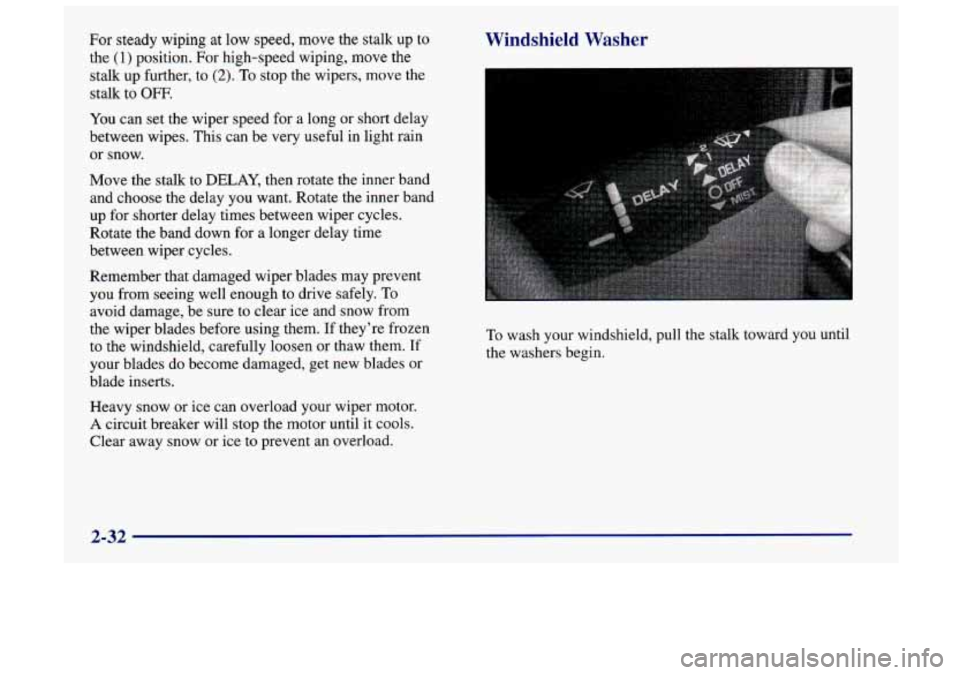
For steady wiping at low speed, move the stalk up to
the
(1) position. For high-speed wiping, move the
stalk up further, to
(2). To stop the wipers, move the
stalk to
OFF.
Windshield Washer
’
You can set the wiper speed for a long or short delay
between wipes. This can be very useful in light rain
or snow.
Nlove the stalk to
DELAY, then rotate the inner band
and choose the delay you want. Rotate the inner band
up for shorter delay times between wiper cycles.
Rotate the band down for a longer delay time
between wiper cycles.
Remember that damaged wiper blades may prevent
you from seeing well enough to drive safely.
To
avoid damage, be sure to clear ice and snow from
the wiper blades before using them.
If they’re frozen
to the windshield, carefully loosen or thaw them.
If
your blades do become damaged, get new blades or
blade inserts.
Heavy snow or ice can overload your wiper motor.
A circuit breaker will stop the motor until it cools.
Clear away snow or ice to prevent an overload.
To wash your windshield, pull the stalk toward you until
the washers begin.
2-32
Page 97 of 356
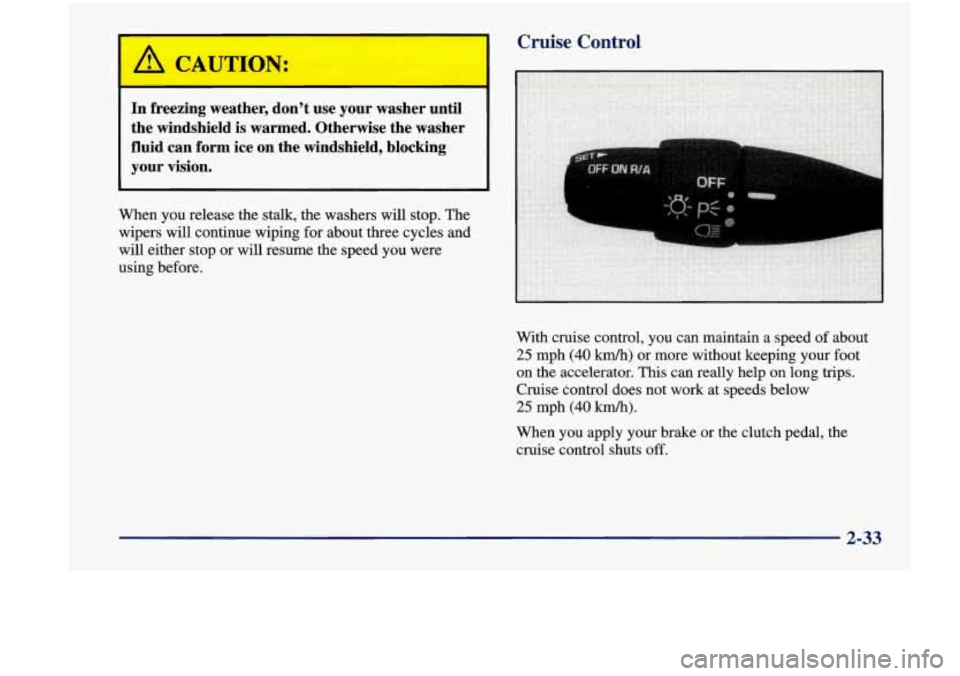
Cruise Control
In freezing weather, don’t use your washer until
the windshield is warmed. Otherwise the washer
fluid can form ice on the windshield, blocking
your vision.
When you release the stalk, the washers will stop. The
wipers will continue wiping
for about three cycles and
will either stop or will resume
the speed you were
using before.
With cruise control, you can maintain a speed of about
25 mph
(40 km/h) or more without keeping your foot
on the accelerator. This can really help on long trips.
Cruise Control does not work at speeds below
25
rnph (40 km/h).
When you apply your brake or the clutch pedal, the
cruise control shuts
off.
2-33
Page 98 of 356
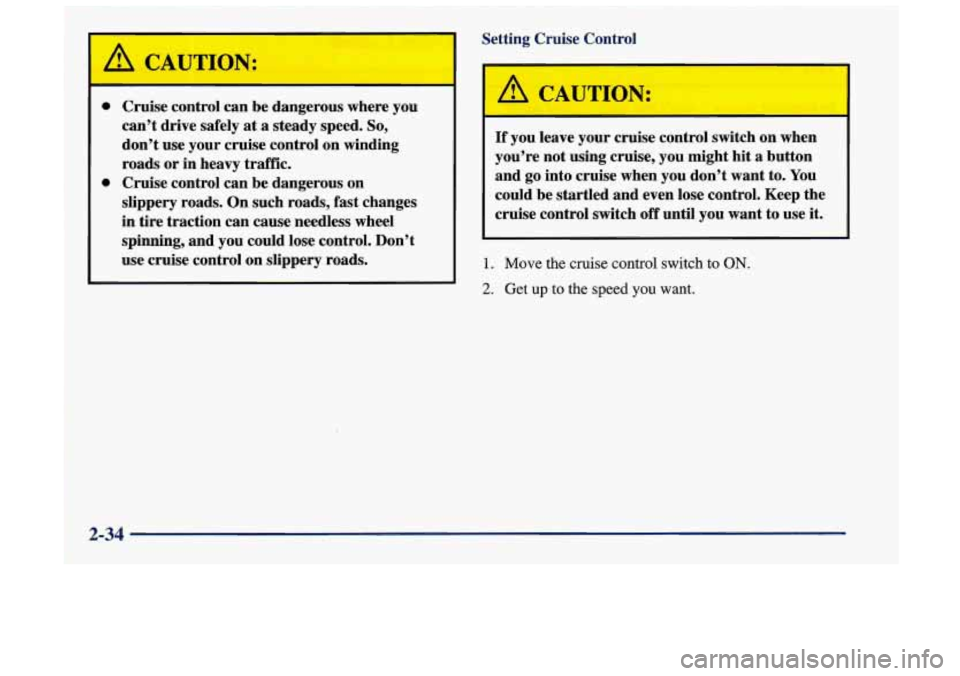
Cruise control can be dangerous where you
can’t drive safely
at a steady speed. So,
don’t use your cruise control on winding
roads or in heavy traffic.
Cruise control can be dangerous on
slippery roads. On such roads, fast changes
in tire traction can cause needless wheel
spinning, and you could lose control. Don’t
use cruise control on slippery roads. Setting Cruise
Control
‘ CA’TTION:
-
If you leave your cruise control switch on when
you’re not using cruise, you might hit
a button
and go into cruise when you don’t want to. You
could be startled and even lose control. Keep the
cruise control switch off until you want to use
it.
1. Move the cruise control switch to ON.
2. Get up to the speed you want.
2-34
Page 99 of 356
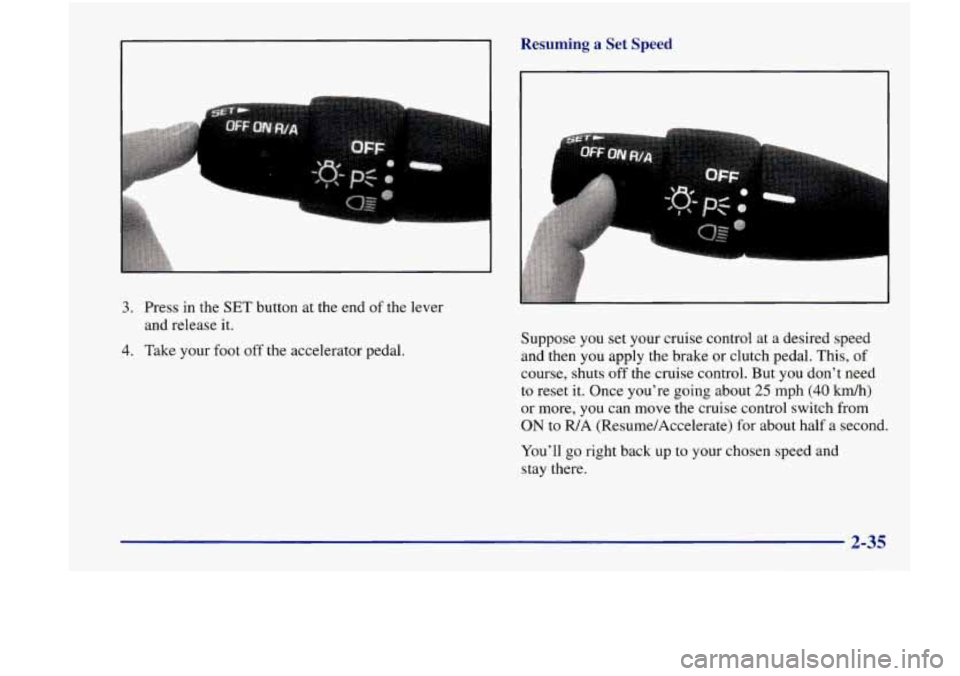
Resuming a Set Speed
I
L. ..
3. Press in the SET button at the end of the lever
and release
it.
4. Take your foot off the accelerator pedal. Suppose
you set your cruise control at a desired speed
and then you apply the brake or clutch pedal. This, of
course, shuts off the cruise control. But you don't need
to reset it. Once you're going about 25 mph (40 kmh)
or more, you can move the cruise control switch from
ON to WA (Resume/Accelerate) for about half a second.
You'll
go right back up to your chosen speed and
stay there.
2-35
Page 100 of 356
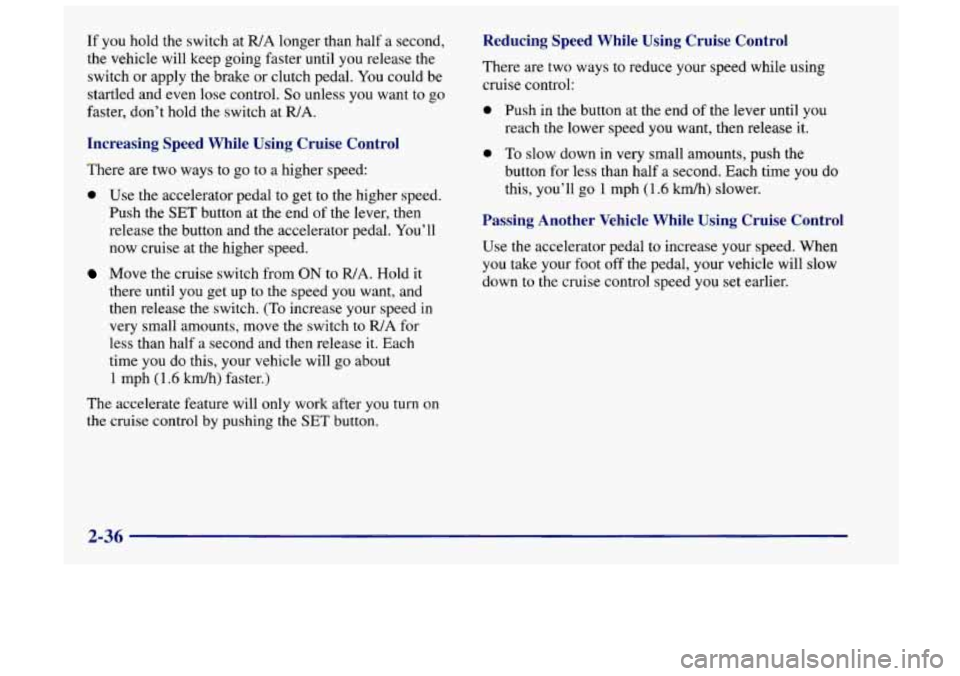
If you hold the switch at WA longer than half a second,
the vehicle will keep going faster until you release the
switch or apply the brake or clutch pedal. You could be
startled and even lose control.
So unless you want to go
faster, don’t hold the switch at WA.
Increasing Speed While Using Cruise Control
There are two ways to go to a higher speed:
0 Use the accelerator pedal to get to the higher speed.
Push the
SET button at the end of the lever, then
release the button and the accelerator pedal. You’ll
now cruise at the higher speed.
Move the cruise switch from ON to WA. Hold it
there until you get up
to the speed you want, and
then release the switch. (To increase your speed in
very small amounts, move the switch to
WA for
less than half a second and then release it. Each
time you do this, your vehicle will go about
1 mph (1.6 km/h) faster.)
The accelerate feature will only work after you turn on
the cruise control by pushing the
SET button.
Reducing Speed While Using Cruise Control
There are two ways to reduce your speed while using
cruise control:
0 Push in the button at the end of the lever until you
reach the lower speed
you want, then release it.
0 To slow down in very small amounts, push the
button for less than half a second. Each time you do
this, you’ll go
1 mph (1.6 km/h) slower.
Passing Another Vehicle While Using Cruise Control
Use the accelerator pedal to increase your speed. When
you take your foot off the pedal, your vehicle will slow
down to the cruise control speed
you set earlier.
2-36